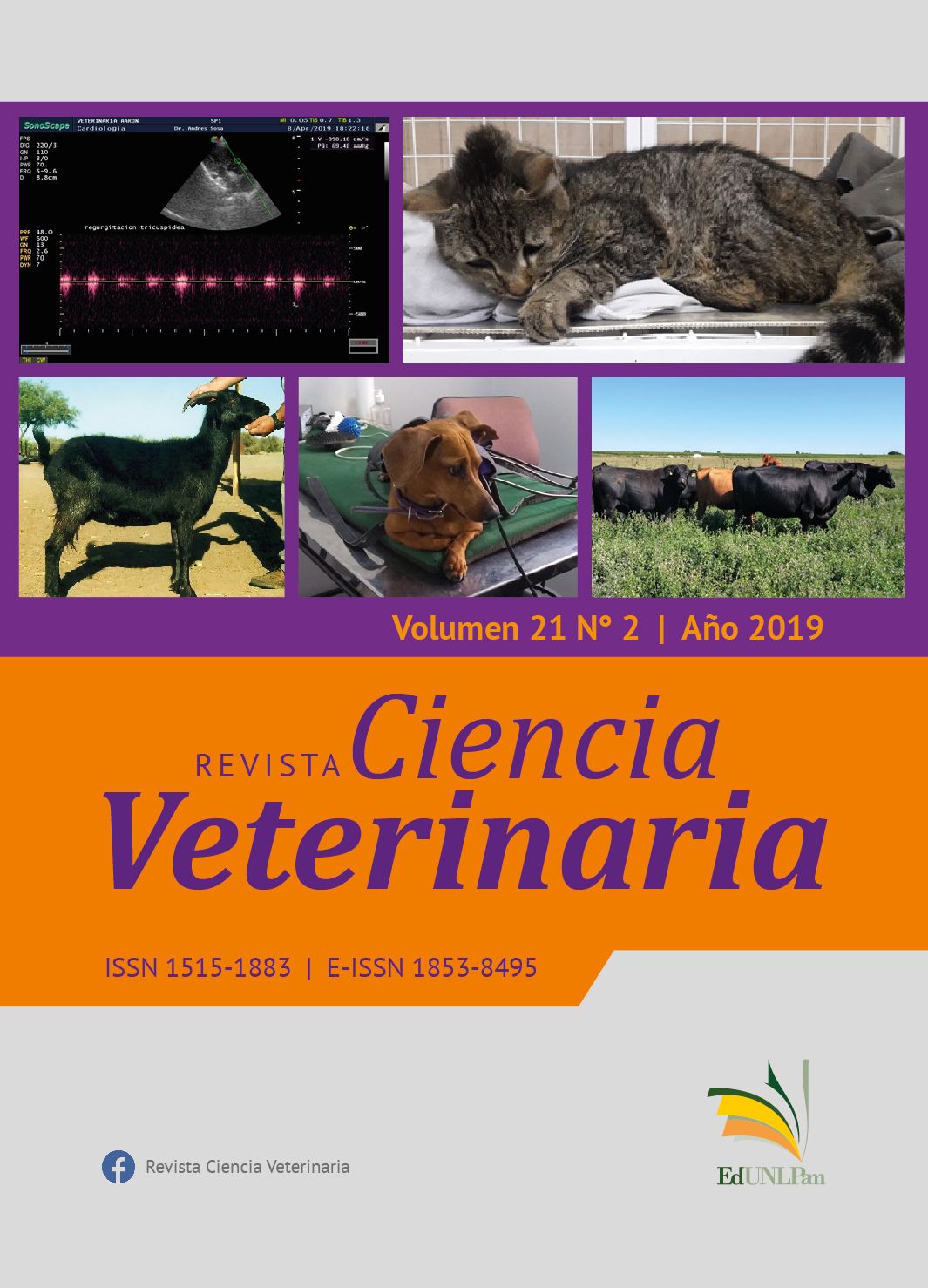Possible clinical leptospirosis in two cats (Felis silvestris catus) from the south of the Santa Fe province
DOI:
https://doi.org/10.19137/cienvet-201921206Keywords:
leptospirosis, cats, microscopic agglutinationAbstract
Leptospirosis is an infectious disease caused by Leptospira spp.. It is not usually considered as part of the differential diagnosis in sick cats, which is a significant risk in public health. Two cases of clinical leptospirosis in cats confirmed by serology are described. They are both European mixed breed, a 13-year-old female and a 7-year-old male, castrated and from two towns in the south of Santa Fe province. They are hunters with indoor/outdoor habits, and live with other animals. They were admitted into the clinic due to progressive weight loss, anorexia and hematuria. Blood tests were taken to obtain complete blood count, blood biochemistry and serological determinations were performed to detect Leptospira spp, feline immunodeficiency virus (FIV) and feline leukemia (FeLV). The results of the hemogram, the hepatic and renal profile together with the symptomatology, comfirmed the suspicion of an alleged leptospirosis. Antibodies against Leptospira spp were detected in both cats and, in the male for FIV as well. Using the microscopic agglutination technique (MAT), the following serovars and antibody titles were detected in the female: Pomona 1: 100, Icterohemorragiae: 1: 200, Canicola: 1: 200 and Grippothyphosa 1: 100 and in the male: Pomona 1: 6400, Icterohaemorrhagiae 1: 400 and Bratislava 1:50. A treatment with benzathinic and procaine benzylpenicillin and streptomycin 10000 IU/l/kg subcutaneously was applied every 24 hours for 20 days as an antibacterial therapy. Subsequently, oral 10 mg/kg doxycycline was used for 30 days with the addition of a vitamin complex. In the male, ampicillin sulbactam 20 mg/kg was administered intravenously every 12 hours. In both cases the evolution was favorable, confirming the clinical efficiency of beta-lactam antibiotics for the disease treatment. The female recovered. In the male, antibacterial chemotherapy was interrupted and died.
Downloads
References
Schuller S, Francey T, Hartmann K, et al. European consensus statement on leptospirosis in dogs and cats. J of Small Animal Practice. 2015; 56:159–179.
Stanchi N, Martino P, Gentilini E, et al. Microbiología Veterinaria. Inter-Médica; 2007.
Picardeau M. Diagnosis and epidemiology of leptospirosis. MédMaladiesInfect.
;43: 1-9.
Azócar-Aedo L, Smiths HL, Monti G. Leptospirosis in dogs and cats: Epidemiology,
clinical disease, zoonotic implications and prevention. ArchMedVet. 2014; 46:
-348.
Markovich JE, Ross L, McCobb E. The prevalence of leptospiral antibodies in free
roaming cats in Worcester County, Massachusetts. J VetInternMed. 2012; 26: 688-689.
Peixoto Ribeiro T, Dias Santos H, Pereira Sousa S, Rocha Galvão S, Silva Reis T, de
Sá Jaime V. Infecção por Leptospiraspp. em Gatos (Felissilvestriscatus). Uma Revisão.
Brazilian Journal of Hygiene and Animal Sanity.2018; 12 (1):101-119.
Hartmann K, Egberink H, Pennisi MG, et al. Leptospira Species Infection in Cats:
ABCD guidelines on prevention and management. J of Feline Medicine and Surgery.
;15(7):576-81. doi :10.1177/1098612X13489217
Larsson CE, Santa Rosa CA, Hagiwara MK, et al. Prevalence of feline leptospirosis:
serologic survey and attempts of isolation and demonstration of the agent. Int J Zoonoses 1984; 11 (2): 161-9.
Arbour J, Blais MC, Carioto L, Silvestre D. Clinical leptospirosis in threecats
(2001-2009). J Am AnimHosp Assoc. 2012; Jul-Aug; 48 (4):256-60. doi:10.5326/
JAAHA-MS-5748
Rodríguez J, Blais M C, Lapointe J, Arsenault L, Carioto L, Harel J. Serologic and urinary PCR survey of leptospirosis in healthy cats and in cats with kidney disease. J Vet Intern Med. 2014; 28:284-293.
Ojeda J, Salgado M, Encina C, Santamaría C, Monti G. Evidence of interspecies transmission of pathogenic Leptospira between livestock and a domestic cat dwelling in a 5 dairy cattle farm. J Vet Med Sci. 2018; 80(8):1305-1308.
Ward MP. Seasonality of canine leptospirosis in the United States and Canada and its association with rainfall. Prev. Vet. Med. 2002; 56 (3): 203-13.
Luna AM, Moles CL, Gavaldón RD, Nava VC, Salazar GF. La leptospirosis canina y su problemática en México. Rev. Salud Anim. 2008; 30 (1): 1-11.
Poli GL, Prado A, Guerra N y Francois SE. Casos clínicos de leptospirosis en perros.
Drovet News. 2016: 21-23
Downloads
Published
How to Cite
Issue
Section
License
Al momento de enviar sus contribuciones, los colaboradores deberán declarar , de manera fehaciente, que poseen el permiso del archivo o repositorio donde se obtuvieron los documentos que se anexan al trabajo, cualquiera sea su formato (manuscritos inéditos, imágenes, archivos audiovisuales, etc.), permiso que los autoriza a publicarlos y reproducirlos, liberando a la revista y sus editores de toda responsabilidad o reclamo de terceros , los autores deben adherir a la licencia Creative Commons denominada “Atribución - No Comercial CC BY-NC-SA”, mediante la cual el autor permite copiar, reproducir, distribuir, comunicar públicamente la obra y generar obras derivadas, siempre y cuando se cite y reconozca al autor original. No se permite, sin embargo, utilizar la obra con fines comerciales.







4.png)


7.png)



